Violin Cleaning and Care
Share
Care and Maintenance of a Violin
Daily care and maintenance
The golden rule: wipe after playing!
The varnish on a violin is very delicate. The tone of violins, guitars, and other acoustic instruments is influenced to a great degree by the varnish, making it an important element of the instrument. Thus, to keep the finish in good condition, always wipe the instrument after playing. This is an iron-clad rule. The instrument should be wiped with a cloth specially designed for this purpose, or a chamois.
Where possible, one cloth should be used only for the strings and the fingerboard, which should be wiped well. If the strings are thick with rosin, their tone will suffer and may produce noise. The fingerboard easily becomes dirty with sweat from the fingers. Normally, a dry cloth is used to wipe down the instrument, but if there is a significant build-up of rosin or other matter on the top plate, please consult a specialist.
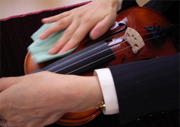
After playing, always wipe.
Once you are done playing and have wiped the instrument, always put it in the case. The violin is so delicate that it may start to creak and pop if exposed to the wind of an air conditioner. The optimum humidity for a violin is 50%. To keep the violin's environmental conditions as close as possible to this ideal, make a habit of putting the violin in its case immediately.
Storing your violin
Violins are sensitive to changes in temperature and humidity. If they are kept stored in high humidity and temperature the top plate and bottom plate will swell, changing the thickness of the body and causing the sound post to collapse. Conversely, if the instrument is kept in a dry environment for long, the fingerboard could detach from the body. Violins should therefore be stored in environments where the humidity and temperature are kept as stable as possible. If just being a room gives you a cold or makes you feel uncomfortable, it's probably a poor choice as a place to store your violin.
Another point to consider is that the body of the violin has many curves, so it's not safe to just place somewhere without any thought. Note also that the varnish on the violin should not be exposed to direct sunlight. You should therefore store your violin in its case, in a safe location.
Be cautious with cleaners that contain polish
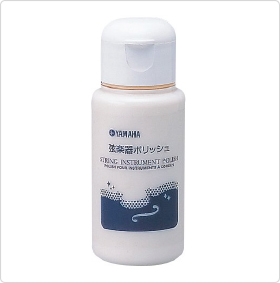
Yamaha's Stringed Instrument Polish, which can be safely used even by beginners.
The regular care of stringed instruments consists of wiping the instrument with a dry cloth specially designed for stringed instruments each time after playing. Normally, this is all that is needed, but when used over a long period of time, the violin acquires an unavoidable build-up of rosin dust around the bridge, and of grease and fingerprints on the fingerboard and other places where the skin comes into direct contact with the instrument. Use a cleaner to clean the instrument when this build-up becomes noticeable. This not only removes the build-up but also restores luster to the varnish.
There are many types of cleaner on the market, and they differ primarily in the type and volume of the polish that they contain. Simply put, those without polish do not have the strength to remove a great deal of dirt, but they are kind to the instrument. In contrast, those with polish remove build-up, but may also harm the instrument.
One polish that is used by both beginners and pros alike is Yamaha's Stringed Instrument Polish. It contains no polish and so is safe to use with any instrument. Of the other products that contain polish, Hill & Sons from England and Millant from France are both famous.
All cleaners are used basically in the same way. Using two cloths specially designed for stringed instruments, put a small amount of polish on one to remove the dirt, and use the other to wipe down the instrument after the dirt is removed. If the same cloth is used for both purposes, the instrument will become dirty again, so be sure to use two cloths. When using a cleaner that contains polish, shake the bottle well before using, and be careful not to wipe hard. However, cleaners that do contain polish will inevitably remove a very small amount of the varnish and so should not be used on old instruments. If there is some resistant dirt that does not come off with normal polishing, consult a specialist.
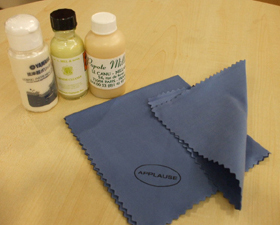
All cleaners are used in the same way. Using two cloths specially designed for stringed instruments, put a little bit of polish on one to remove the dirt, and use the other to wipe down the instrument after the dirt is removed.
Care and Maintenance of a Violin
Changing the strings
When should the strings be changed?
Strings on the instrument will eventually lose their shape and their tonal qualities. The strings should be changed regularly to maintain good tone quality. How much you play is also a factor, but all strings should be changed at least once a year.
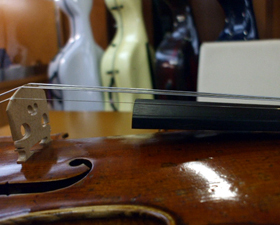
Strings should be changed at least once a year.
Change your own strings
First, spread a mat on top of a table. Then, to protect the instrument, spread a cloth on the lower half of the body underneath the tailpiece. The bridge will come loose if the strings are all removed at once, so strings are changed one at a time. First, completely loosen the tuning peg and remove it from the peg box, then remove the string from the peg box hole. At the tailpiece, the small, round, metal part at the end of the string is simply wedged in the groove of the adjuster, so you can easily remove this as well.
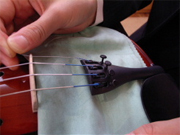
Spread a cloth to avoid damaging the instrument.
Return the tuning peg to the peg box, put the end of the new string in the adjuster, and thread the other end of the string on the tuning peg and wind it up. Be sure to wind the string from the inside of the peg box to the outside, and tighten it enough to properly place it on the bridge. Once all the strings have been replaced, check and adjust the position of the bridge, and then tighten one string at a time to tune it.
This is not difficult work, so at least try doing it yourself first!
The E and A strings break easier than the others, so it is advisable to always keep an extra set in the case.
Care and Maintenance of a Violin
Occasional maintenance
For the best tone, rehair the bow regularly
Of all the inquiries about the repair of stringed instruments, most are inquiries about the bow and of these, 80% are requests to rehair the bow. The violin is played using rosin on the hair to make it cling to the strings, but when rosin dust is absorbed into the hair, the surface of the hair becomes slippery, and the bow will not cling to the strings, no matter what type of rosin is used. Thus, when the bow will no longer cling to the strings, it is time to rehair the bow. As a guideline, beginners should rehair every six months to a year.
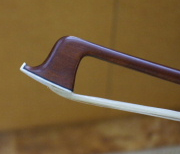
This is the head of the bow. Adhered to the head is a white part called the chip.
Another problem with the hair is that it stretches and shrinks depending on the season. During the dry winter months, the hair shrinks, and no matter how much you loosen the screw, the hair is not loose enough. In contrast, during the summer, the high humidity causes the hair to stretch, and no matter how much you tighten the screw, the hair is not tight enough. Sometime an adjustment is all that is needed, but in many cases rehairing is required. Regular rehairing is advisable for the best tone.
The most important part of the bow is the head. If you look closely, you will notice that each bow head is a different shape and size, giving individual bows their own distinctive character. This chip often becomes cracked. Both bone and plastic are used to make the chip, but the plastic type is easily cracked. To fix a cracked chip, the old chip must be removed and a new chip glued to the head.
In addition, the bow is very delicate and should be stored in the instrument case when not in use, but some people accidentally put it in the wrong way. As shown in the picture, the bow should be inserted with the head secured by the strap. If the bow is put in facing the other direction, the head will rattle around.
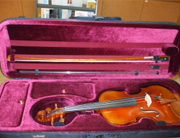
Be careful to secure the head when storing the bow.
If high humidity is a concern
If high humidity is a concern, the violin case can be made dry and cool for safe storage of the instrument. Some cases come with a thermometer and hygrometer built in, but even for those that do not, a hygrometer can be put into the case. For more protection, there are products that can help control humidity, those that remove humidity only, and others that prevent both too much and too little humidity. The most inexpensive of these start at about US $9.00. Products that only remove humidity are used during periods of high humidity, while the dual action type can be used all year round and can normally be left in the case.
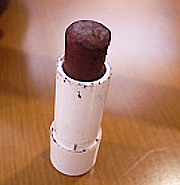
Peg compound for making the tuning peg easier to turn
During periods of high humidity, the tuning pegs become hard to turn because of the swelling of the wood. Peg compound is a useful tool at these times and makes it easier to turn the tuning pegs. Keep some peg compound on hand in seasons with lots of rain. Apply the compound only to the parts of the tuning peg that come into contact with the peg box.
What if the bridge is crooked?
Lift the violin up to eye level and look straight across the bridge. The bridge on the tailpiece side should be standing perpendicular from the top plate when looking directly from the side.
However, the tension of the strings constantly pushes the bridge down toward the top plate, and the bridge can easily become crooked. Be careful! This can cause the feet on the bridge to deform, or can even cause the bridge itself to bend. If the bridge becomes crooked when you tune the instrument, the bridge may have deformed, and you should have an expert take a look.
To adjust the bridge yourself, follow the procedure below:
- Look at the violin from the side and check the angle of the bridge.
- If it is not perpendicular, slightly loosen the strings, then carefully move the bridge into place.
When doing this, be sure to stabilize the instrument by laying it on your lap and cradling the corners of the violin with both hands (from your wrist to the base of your little finger). Then, grip the bridge from above with the index fingers and thumbs of both hands, and carefully move the bridge into alignment. - Tune the instrument and check the angle of the bridge again.
Continue until the bridge is perpendicular. If this is the first time for you to do this kind of work, it's a good idea to have someone who has done it before observing you.
If the sound post falls down, can I fix it myself?
The sound post is only wedged between the top and bottom plates, and sometimes it falls down. It will be obvious when the sound post falls because it will rattle around inside the instrument. When this happens, have a professional fix it rather than trying to fix it yourself. The sound post is installed using a special tool (see photo). Once the sound post is wedged between the plates, it is lightly tapped to move it into the proper position little by little. This is very difficult to do for all but the most seasoned professionals. However, if the sound post is not perfectly straight or its position is off even by a few millimeters, the tone of the instrument will be degraded.
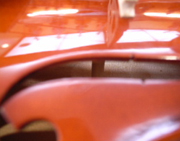
The sound post can be seen through the f-hole
Some people think they would like to try to fix the sound post themselves, but this is unadvisable as attempting to do so may damage the instrument. It is strongly advised that you leave it to a professional.

The tool used to install the sound post.
The peg is too loose and cannot be tightened!
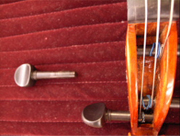
When a peg becomes loose, remove it from the peg box and apply some chalk to it.
When the climate is very dry, loose pegs are a common problem. This is because the wood becomes dry and shrinks, causing the pegs to become loose in the peg box. In the worst cases, the peg spins freely inside the peg box. To resolve this problem, completely loosen the pegs and remove the string, then apply chalk to the peg to help create friction. It is not necessary to apply chalk or rosin to the entire peg, only those parts that come into contact with the peg box. Needless to say, when the climate is humid, the wood swells, and the peg is difficult to turn. Thus, if the peg box holes and pegs just happened to be produced in the cold winter months, there will likely be significant problems with these parts come summer. However, there are some cases where it is not just a problem of dryness but rather a problem of age that requires a physical solution. If chalk does not solve the problem, you must consult an expert.
Fitting the rubber parts of the shoulder rest
Replacing the rubber part on the shoulder rest requires a considerable amount of strength. To minimize resistance when fitting the rubber part, first apply a drop of water with your finger or the like to the part of the foot of the shoulder rest that is bent most sharply. Apply a single drop to both the front and rear of the bent portion. Next, insert the rubber part carefully, like you are stroking it. After fitting it, use a cloth to wipe away any remaining water.
Care and Maintenance of a Violin
Bow maintenance
How to maintain the beauty of the curve
The first and most basic rule of bow handling is to tighten the hairs before playing, and loosen them right after playing. The curve of the bow is very important, and if the tension of the hair is not released, the bow may lose its curve. If the bow looses its curve, it looses its elasticity, which makes it difficult to apply pressure and impossible to produce a sound.
Rosin dust will inevitably adhere to the stick, so this should be wiped with a cloth after each performance. A lot of rosin accumulates on the inside of the stick, so use a cloth to wipe this area first (see photo).
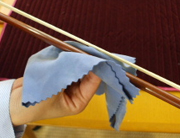
Put the cloth on the inside to wipe the stick
If you touch the hairs with your fingers, rosin will not stick to them, so it is important not to touch the hairs when wiping the stick. Also be sure to wipe the areas that are exposed to sweat, particularly the area where the stick is held.
